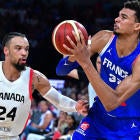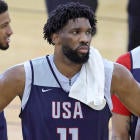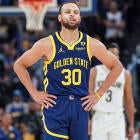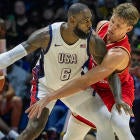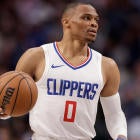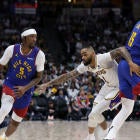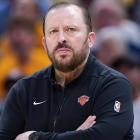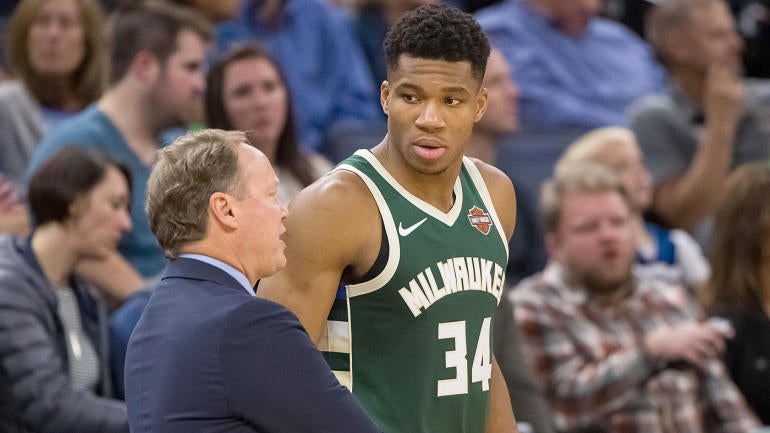
The most important day in the history of the Milwaukee Bucks isn't even officially on the NBA schedule. It might be Nov. 20. It might be Dec. 1. It might, depending on the state of negotiations between the NBA and NBPA, be a good deal later. But whenever the first day of free agency arrives, the Bucks will officially offer Giannis Antetokounmpo a five-year, super-max contract that would kick in after the 2020-21 season concludes, and on that day, Giannis is almost certainly going to say no.
That "no" doesn't have to mean anything. There's common financial sense to it. Kevin Durant proved that not even a serious injury will prevent him from getting the max. Giannis has nothing to lose by waiting. Signing now locks him into a wildly uncertain number. We don't even know what the 2020-21 cap will be, much less the 2021-22 number that his max will be based on. Waiting out the pandemic might mean tens of millions of extra dollars for him. Signing now removes that upside. It also removes his leverage.
Giannis isn't LeBron James. There is no evidence suggesting that he will use his impending free agency to push for certain roster decisions. But he doesn't need to. The Bucks know that anything short of a championship leaves the door open for his departure. A year-long recruiting pitch starts the moment Giannis says "no." Every move the Bucks make from that point forward will be based on getting a "yes" next offseason. The purpose of this offseason preview will be figuring out exactly what kinds of moves the Bucks will try to make in that effort.
One note before beginning: We will be using Spotrac for player salaries, and 2019-20 cap numbers for this exercise as a whole. That includes previously agreed-upon numbers like the rookie scale and the minimum salary. A frozen cap is the likeliest outcome of negotiations between the league and the NBPA, but these numbers could theoretically change in either direction.
Under the assumption that the 2019-20 numbers will be used, these are the pertinent numbers for these projections.
Salary cap | $109,140,000 |
Luxury tax | $132,627,000 |
Luxury tax apron | $138,928,000 |
Salary floor | $98,226,000 |
Non-taxpayer mid-level exception (Year 1) | $9,258,000 |
Taxpayer mid-level exception (Year 1) | $5,718,000 |
Cap room mid-level exception (Year 1) | $4,767,000 |
Bi-annual exception | $3,623,000 |
Cap situation and overall finances
Last offseason, the Bucks traded Malcolm Brogdon to the Indiana Pacers. There was no reasonable basketball motivation for doing so. They acquired a potentially valuable first-round pick from the Pacers, but only days prior, they gave up their own first-round pick to clear Tony Snell off their books. Earlier in the season, they gave up another valuable pick to offload John Henson and Matthew Dellavedova. There have always been rumblings about Brogdon's medical outlook, but no specific injury he has suffered in the NBA tends to be recurring. He hasn't torn an ACL.
The trade was financial. The Bucks, having just paid Eric Bledsoe and owing new contracts to Khris Middleton, Brook Lopez and George Hill, decided that Brogdon was the odd man out. His salary was the difference between the Bucks avoiding the luxury tax and paying it. The thought of doing so last offseason was, apparently, untenable. That has been the organization's stance historically. It hasn't paid the tax once since the new, more punitive rules were put in place in 2011. So Brogdon was offloaded. Look what happened. Milwaukee's late-game offense stood no chance against a prepared Heat defense. Brogdon led the Pacers in clutch scoring. His pick-and-roll mastery was exactly what the Bucks lacked.
That's not the sort of thing Antetokounmpo is going to forget. Free agents almost never do. The Heat waived Mike Miller to duck the tax in 2014. LeBron left after the season, reportedly unhappy with that choice. Durant may never have left the Thunder if they'd just paid James Harden. Stars expect their teams to pay for winning rosters. The Bucks won't get away with crying poverty this time around. They are going to pay the tax this season. They're already fairly close to our projected line.
Players | 2020-21 Salary |
Khris Middleton | $33,051,724 |
Giannis Antetokounmpo | $27,528,090 |
Eric Bledsoe | $16,875,000 |
Brook Lopez | $12,697,675 |
George Hill | $9,590,602 |
Ersan Ilyasova* | $7,000,000 |
$5,005,350 | |
DJ Wilson | $4,548,280 |
$3,044,160 | |
Thansasis Antetokounmpo* | $1,701,593 |
Jon Leuer (dead salary) | $3,169,348 |
Larry Sanders (dead salary) | $1,865,546 |
No. 24 pick | $2,193,480 |
Total | $128,270,851 |
*non-guaranteed
**player option
Not listed here is Wesley Matthews Technically, he has a player option, but unlike Robin Lopez, he has no incentive to pick it up. He took a pay cut all the way down to the minimum to sign with his hometown Bucks and compete for a championship last season, and vastly outplayed that deal. That player option only represents a five percent raise on his minimum salary from a season ago. Through Non-Bird rights, he can get a 20 percent raise from the Bucks by opting out. Even if he wants to stay in Milwaukee, there's no good reason for him not to opt out because they'd gladly give him that 20 percent raise based on his performance. In truth, he'll be able to find more lucrative offers elsewhere if he wants them.
That bump does matter to the Bucks, though, as they have a decision to make in how they manage their meager financial flexibility. There are two feasible paths available to them:
- If they use the taxpayer mid-level exception of $5.7 million, they can add and retain as much salary as they'd like through minimum signings and trades.
- If they use the non-taxpayer mid-level exception of $9.3 million, or acquire any player through a sign-and-trade, they are hard-capped at the apron. As of now, they have around $10 million to work with below that line, but a benefit to this plan for ownership would be its relatively low cost. If they aren't hard-capped, they might have to go more than $10 million above the tax line to build a champion. If they are, there's nothing they can do. They're stuck at the apron and can't be pressured into extra spending, but can still credibly say that they did everything in their power to win.
The first path is the simpler one. It requires no difficult choices. The Bucks could go as far above the tax as their hearts desire. They could make any legal trade that the other team accepts. They'd have no trouble filling out their roster with minimum signings.
The second is infinitely more complicated because, at this moment, the Bucks can barely afford to pursue it. If they spent the entire $9.3 million mid-level exception, they wouldn't have enough space left to fill out the rest of the roster. That's easy enough to remedy. Ilyasova's $7 million is non-guaranteed. But it shows how complicated things become when a hard cap is involved. The upside here is higher, but the sacrifices are greater. Ilyasova is a helpful player. He's also valuable salary filler for trades. If the Bucks go this route, it probably means they're banking on one big addition in free agency and a fairly quiet trade season.
Who would that addition be? In all likelihood, it would be a perimeter scorer. The obvious target here would be a shot creator, but there's another option to consider as well. Miami exposed a pretty glaring weakness in Milwaukee's roster design. The Bucks take a lot of 3-pointers, but they don't actually make many of them. They ranked fourth in 3-point attempt rate last season, but 17th in percentage. The Heat could comfortably build a wall at the rim against Giannis because they didn't trust Milwaukee's shooters to punish them for it. There are free agents on the table who could help solve that issue. If offense is the goal here, there are five targets worth discussing here. Their true availability varies pretty wildly.
- The Athletic's Shams Charania reported that Milwaukee is interested in Sacramento shooting guard Bogdan Bogdanovic. He's the most balanced option here, above average as a shooter and ball-handler while at least surviving defensively. He also carries another major benefit that the next two players don't: age. Bogdanovic is 28. That's not young, but it's younger than Middleton, Hill, Bledsoe and both Lopez twins. Milwaukee's goal is to win now, but proving to Giannis that his window isn't closing after this season matters as well. Bogdanovic's age is going to make him the most expensive option on the table. He's also a restricted free agent, meaning he can't leave the Kings without their approval. This would have to be a sign-and-trade, and it would almost certainly mean a commitment from the Kings to make Buddy Hield their long-term shooting guard. Would the Kings accept only draft compensation? Or would they demand Donte DiVincenzo as a replacement sixth man? That might be what makes or breaks a possible deal, if the Kings are open to one at all.
- Goran Dragic is 34 years old and just missed most of the NBA Finals due to injury. His window for another big contract is closing. Miami's planned pursuit of Giannis will prevent it making a multiyear deal, but with Bird rights, it could offer him up to the max for a single season. If he'd rather have four years of security at over $40 million in total, the Bucks have a shot here, and the secondary advantage is that it would hurt the Heat in a possible playoff rematch. As far as free-agent shot creators go, it doesn't get better than the version of Dragic we saw in the postseason. Given his age, though, it's worth wondering if that player is the one Milwaukee will be signing.
- Danilo Gallinari comes up in every one of these previews because he'd fit anywhere and has indicated that he'd leave money on the table to join a winner. The Bucks are a winner, and they'd love to add one of the NBA's best shooters. The mid-level exception may or may not be enough, but even if it isn't, the Thunder appear more than willing to cooperate in a sign-and-trade. The question here, aside from defense, is Milwaukee's appetite for risk. Gallinari has had two largely healthy seasons in a row. In the four seasons prior, he missed an average of 33 games. He sat out the entire season before that stretch recovering from a torn ACL.
- Davis Bertans, like Bogdanovic, would need to come in a sign-and-trade. All signs coming out of Washington suggest that the Wizards just want to re-sign Bertans, and his defense might be too problematic for late-stage playoff games anyway. But the Bucks already have a one-man fastbreak in Giannis. Adding Bertans, perhaps the NBA's best transition shooter, would be borderline unfair.
- Joe Harris needs to be mentioned for his shooting, but he should be characterized as extremely unlikely. The Nets have full Bird rights on him, and unlike the Heat, they'll have no misgivings about a multiyear deal. They'll pay up to keep him, and even if they didn't plan to, they wouldn't strengthen a rival by cooperating in a sign-and-trade with the Bucks. That means he'd have to take the MLE to come, and he'll get better offers elsewhere.
The challenge Milwaukee would face in using the lighter taxpayer mid-level exception is how poorly this free-agent class is geared toward their needs. Teams looking for centers will have endless options in the taxpayer mid-level area. The Bucks don't need one. They need a point guard. The best in this class after Dragic is D.J. Augustin, who does little for them that Bledsoe doesn't already do better. There are great shooters in this class, but mostly of the flawed variety that doesn't have much use to Milwaukee in a playoff setting. Bryn Forbes isn't closing Eastern Conference finals games against the Celtics or Nets.
The Bucks would be able to find a good, supporting player with the taxpayer mid-level exception. That player just wouldn't solve their fundamental issues. If that is the route they take, they have to address the bigger problems through the trade market, and to do that, they have a decision to make about their draft capital.
Draft capital
- 2020 picks: No. 24
- Owed future first-round picks: 2022 to Cleveland (top-10 protected 2022 and 2023, top-eight protected 2024, becomes two second-round picks if it has not yet conveyed).
- Incoming future first-round picks: N/A
The Bucks have a decision to make. By virtue of the protections on the pick they owe Cleveland, they can trade no more than one future first-round pick in addition to No. 24. That pick would come in either 2026 or 2027, and on paper, could be quite valuable. If Giannis remains in Milwaukee, one would presume that they'll likely be later picks. If he leaves? Those picks could be at the top of the lottery.
Would the Bucks trade an unprotected future pick in a bid to improve around Giannis while they have the chance? There's no precedent for it. Cleveland didn't in either LeBron tenure. Oklahoma City didn't in its last gasp to retain Durant either. The consensus belief is that the risk outweighs the reward, but how risky is it, really? If the Bucks are in a position to lose a top-five pick, it probably means they'll be bad enough to remain there. That pick would be five years out as well, more than enough time for them to reload.
There's also an argument suggesting that the reward just wasn't great enough for Cleveland or Oklahoma City to consider doing such a thing. Might it be for Milwaukee? Possibly. There are reasonably priced stars on the market, but if the Bucks want to trade for one of them, they have to offer something of value. Beyond DiVincenzo, they don't have much outside of a possible future pick. If the Bucks want championship-caliber reward, they might have to accept a championship-caliber risk.
Trade options
Any blockbuster would almost certainly include Bledsoe as most of the salary filler, and perhaps Ilyasova as well. Either DiVincenzo or draft capital would represent the asset side of the arrangement. The goals here would be the same as they are in free agency: ball-handling and shooting. Four immediate big-name targets come to mind.
- The Athletic's Eric Nehm has reported that a Chris Paul trade is unlikely due in large part to cost. That's unfortunate, because no single player better fits what the Bucks need than Paul. He fills both the shooting and ball-handling gaps without taking much off the table defensively. His aging body would enjoy Mike Budenholzer's preference for limiting the minutes of his stars. Yes, the notion of absorbing the final year on Paul's deal without Giannis isn't exactly ideal, but if necessary, Milwaukee could let it lapse without ever paying the repeater tax. The Bucks should trade for Chris Paul. They may never have another chance to acquire a Second-Team All-NBA player with Giannis on board. It just doesn't look like they're willing to do it.
- Jrue Holiday is hardly cheap at $26.1 million, but that's $15 million less than Paul is owed, and he is expected to opt out of the final year on his deal in the 2021 offseason. That may make him more desirable than Paul, but it also makes him more desirable to every other team. The Bucks can't outbid Brooklyn, Indiana or Golden State. They might not be able to outbid Denver. This sort of trade only happens if the Bucks are willing to take the plunge on an unprotected future first-round pick. Even then, the Nets could still offer more.
- The Ringer's Kevin O'Connor reported that the Bucks and Pacers have discussed Victor Oladipo, but a deal is unlikely at this point. That's probably for the best. Oladipo has one All-NBA season under his belt and didn't come remotely close to that level after returning from injury last season. He might be a star again someday, but he's not the sort of player Milwaukee should bet Antetokounmpo's future on.
- The Kings are probably going to make an either/or decision on Bogdanovic vs. Buddy Hield. The Bucks can target whoever they decide against keeping. Hield isn't as versatile as Bogdanovic, but his shooting makes up for it. His four-year contract extension could get ugly if Giannis leaves, though.
These are complicated deals that include players who should have multiple suitors. None should be viewed as likely, but the Bucks should have some more modest options available to them, especially if they're willing to make trades that don't end with them getting the best player.
- The Clippers sorely need a point guard and would probably love Bledsoe. They have an end-of-game scorer in Lou Williams and an elite 3-point shooter in Landry Shamet. If the Bucks could grab JaMychal Green while they're at it, a Clippers deal makes some sense.
- A three-team option: Bledsoe goes to the Lakers, well known for their affinity for players represented by Klutch Sports. Danny Green goes to the Mavericks, one of the teams that pursued him in free agency in 2019. He would improve their No. 18-ranked defense, which needs far more help than their historically efficient offense. Milwaukee takes on Dwight Powell's contract and gets Seth Curry to juice their shooting. This deal also clears an extra $19 million or so off Dallas' books for the 2021 offseason so they can sign a long-term Curry replacement after Green's deal expires.
- The desperation move: Derrick Rose for Ilyasova and the No. 24 pick. He's not a shooter and doesn't defend, so the fit is questionable, but he can create shots late in games. If that's the criteria, he's worth a look. He could run an effective pick-and-roll with Giannis, at the very least.
These moves all fall under the same umbrella as Milwaukee's free-agent options: interesting but imperfect. The best choice is the one they aren't going to make.
What would an ideal offseason look like?
The answer for Milwaukee is the same as the answer for Philadelphia: Trade for Chris Paul. He solves all of their problems, and asking the Bucks to pay the tax for the last two years of Paul's deal is more than fair. The upside here is a championship. But the Bucks aren't going to do this, so it doesn't warrant further explanation. The other big trades on the board are out of their control. They can't win bidding wars for Holiday, Bogdanovic or Oladipo if other teams seriously engage. Those players may not even be traded.
So given the realistic options on the board, the likely best case is using either the full mid-level exception or a sign-and-trade, thus triggering a hard cap. That's a tough pill to swallow, especially since it means waiving Ilyasova and losing him as possible salary filler for an in-season trade. If that's what it takes to get either Dragic or Gallinari, though, it will have been worth it. Dragic would probably be preferable, but Gallinari appears more attainable.
After that, the idea is to maximize the minimum slots at the back of the roster. If Matthews wants one, he should be welcomed back with open arms. Beyond him? Look for ring-chasing veterans who can shoot. Kyle Korver deserves a spot if he wants to return. A slightly crazier option: Carmelo Anthony. He has many, many flaws, but individual shot creation isn't one of them. Considering the hard-cap restrictions, it might make sense for the Bucks not to guarantee contracts to 15 players, instead relying on two-way and 10-day contracts during the early portion of the season so they'll have a roster spot and some cash to spend on the buyout market. They'd love another Marvin Williams-caliber addition this time season.
And then? Just keep an open mind on the trade market. New possible targets might emerge. Just because an ideal and affordable shot-creator or shooter isn't available right now doesn't mean he won't be at the deadline. Milwaukee's system is fairly simple and easy to fit into. The Bucks shouldn't be afraid of in-season deals.
No, this strategy doesn't hold a candle to the far simpler "just trade for Chris Paul and call it a day," plan, but it should be noted that the Bucks don't have very far they need to go here. They've been the NBA's best regular-season team for the past two seasons, and a single flaw has been responsible for both of their playoff losses. For all we know, that flaw is solved internally by improvement from Giannis. The field might be weaker. There are a number of viable scenarios in which the Bucks win a championship without doing anything particularly grand this offseason. But if they avoid big moves and don't win the championship? They'll have a lot to answer for when Giannis does reach free agency. Their window to impress him is about to open. If they don't jump through, they'll have nobody to blame but themselves when somebody else does.










